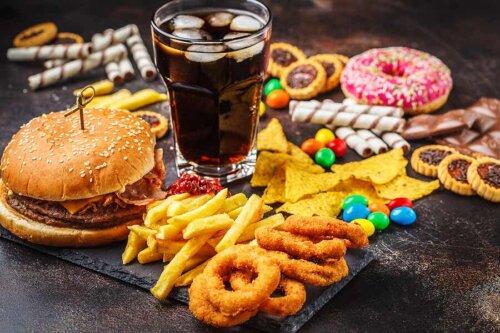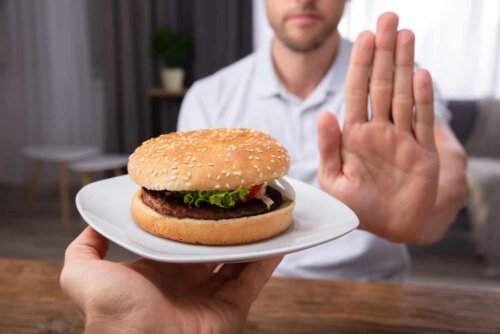The Consequences of Eating Hyper Palatable Food


Written and verified by the nutritionist Maria Patricia Pinero Corredor
Hyper-palatable food replaced traditional ones around the end of the 20th century. These kinds of products basically have a high content of saturated fats, refined sugars and flours, and salt. This means that their ingredients are energy-dense and can even be addictive.
Some specialists say that the food industry adds artificial substances to hyper-palatable products in order to enhance flavor, give them a longer shelf-life and make them ready to consume. These ingredients, especially sweet creamy ones, trigger certain reactions in the brain. Most of us associate them with positive feelings of pleasure. Thus, they increase the desire to eat more of them.
There are just a few steps from tasty to dangerous in hyper-palatable foods so read on to learn more about the risks of consuming them.
What’s hyper-palatable food?
Other specialists have written in World Nutrition magazine and state that hyper-palatable food derives from industrial formulations. Either that or they’re made with substances extracted or derived from edible goods. They indicate that ultra-processed foods are hyper-palatable.
Usually, these products are a mix of saturated or trans fats, refined sugars and flours, and salt. The industry mixes them with food derivatives – such as hydrogenated oils, modified starch, hydrolyzed proteins, and meat extrudates.
They also state that they contain many additives such as preservatives, emulsifiers, binders, stabilizers, sweeteners, sensory, and flavor, and color enhancers. It’s all for the purpose of making the product look, smell, feel and taste like actual food.
In the International Journal of Obesity, some researchers conclude that the perception of such ingredients leads to the same kind of behavior as that of drugs. That is, they activate the reward circuits in the brain and this leads to the overconsumption of hyper-palatable food.
According to Appetite magazine, hyper-palatable foods include soft drinks, sweet and salty snacks, candies, fried foods, artificial juices, fast foods (hamburgers, pizzas, French fries), reconstituted meat, instant soups, sugary cereals, packaged sweets, and ready meals, among others.

How to identify hyper-palatable food
Anyone could say that identifying a hyper-palatable food is quite easy, as those that cause addiction are among the most popular. However, people often describe them without defining their specific characteristics.
Based on the need to better identify them, the journal Obesity published a study that sheds light on the issue:
- Industrial foods providing 25% of calories from fat and contain more than 0.3% of their weight in sodium such as wieners, processed meats, and egg- and milk-based products.
- Products with more than 20% of calories from fat and more than 20% from sugars, such as ice cream, cakes, and pastries.
- Also, those with 40% of calories from carbohydrates and more than 0.2% of their weight in sodium like potato chips, popcorn, and crackers, among others.
An analysis of the US Food and Nutrient Database for Dietary Studies found that 62% of almost 8000 foods are hyper-palatable, as they have a high fat and sodium content.
In addition, 5% of foods labeled as “low in fat, sugar, salt or calories” are also hyper-palatable such as vegetables cooked in sauces, fats, or creams.
The report notes that the method of food preparation and processing can determine whether a food product is hyper-palatable or not. The combination of ingredients establishes it.
Hyper-palatable food is bad for your health
There are a number of reasons why hyper-palatable food may be hazardous to health.
1. These increase the risk of chronic diseases
The World Health Organization published that many studies reveal an association between the intake of highly palatable ultra-processed foods and chronic non-communicable diseases. Such is the case of cardiovascular diseases, obesity, type 2 diabetes, and hypertension, among others.
In addition, the consumption of these foods at an early age may increase abdominal obesity, according to a study conducted by Costa and other researchers. Thus, we must reinforce preventive strategies on the consumption of energy-dense and highly palatable foods.
2. They produce less satiety
The components that are part of hyper-palatable foods lead to uncontrolled overeating, as these impair the satiety signals in the brain and people eat more. Nutricao magazine points out that this situation is conducive to obesity.
3. Hyper-palatable food creates addiction
Appetite magazine indicates that a vicious circle begins when ingesting hyper0-palatable foods. The presence of certain ingredients that give pleasure activates the brain’s reward circuits.
In the end, there’s an uncontrolled consumption of these foods. There’s also a link between it and an increased risk of obesity.
Learn about 15 Foods that You Should Avoid at All Costs
4. These foods provide fewer nutrients
Addiction to hyper-palatable foods displaces the consumption of natural or minimally processed foods, sources of fiber, vitamins, minerals, and proteins. In addition, their formulations are based on fats, sugars, or carbohydrates that fail to meet the requirements mainly.

5. They disturb the mood
A review notes that anxiety is related to the consumption of hyper-palatable food, such as pizza, sodas, french fries. They observed that a prolonged intake of processed and sugary foods is related to an increased risk of depression.
They also found that people with a preference for fast food to mitigate psychological distress are 25% more vulnerable to being obese.
In addition, the journal Frontiers in Psychology published that the consumption of sweet high-fat foods reduces the signs of stress and anxiety. Thus, obesity is more likely.
Hyper-palatable food doesn’t belong in a healthy diet
Hyperpalatable foods increase the risks of chronic diseases and psychological disorders. This is why they don’t belong in a wholesome diet.
Natural products such as fruits, vegetables, and nuts are a better choice for crunchy appetizing snacks. Consult a nutrition professional if you have questions or feel you cannot stop consuming ultra-processed foods, despite your best efforts.
All cited sources were thoroughly reviewed by our team to ensure their quality, reliability, currency, and validity. The bibliography of this article was considered reliable and of academic or scientific accuracy.
- Rodríguez-Santos, F., Aranceta, J., Serrá, Ll. Psicología y Nutrición. Elsevier Masson. España. 2008. Disponible en: https://books.google.com.cu/books?id=wQeGnfOH64MC&printsec=frontcover#v=onepage&q&f=false
- Sharma S, Fernandes MF, Fulton S. Adaptations in brain reward circuitry underlie palatable food cravings and anxiety induced by high-fat diet withdrawal. Int J Obes (Lond). 2013 ;37(9):1183-91.
- Moubarac JC, Batal M, Louzada ML, Martinez Steele E, Monteiro CA. Consumption of ultra-processed foods predicts diet quality in Canada. Appetite. 2017 Jan 1;108:512-520.
- Costa CS, Rauber F, Leffa PS, Sangalli CN, Campagnolo PDB, Vitolo MR. Ultra-processed food consumption and its effects on anthropometric and glucose profile: A longitudinal study during childhood. Nutr Metab Cardiovasc Dis. 2019 Feb;29(2):177-184.
- Arnaiz Mabel Gracia. La emergencia de las sociedades obesogénicas o de la obesidad como problema social. Rev. Nutr. 2009; 22( 1 ): 5-18. Disponible en: http://www.scielo.br/scielo.php?script=sci_arttext&pid=S1415-52732009000100001&lng=en
- Hepworth R, Mogg K, Brignell C, Bradley BP. Negative mood increases selective attention to food cues and subjective appetite. Appetite. 2010 Feb;54(1):134-42.
- Opie RS, O’Neil A, Itsiopoulos C, Jacka FN. The impact of whole-of-diet interventions on depression and anxiety: a systematic review of randomised controlled trials. Public Health Nutr. 2015 Aug;18(11):2074-93.
- Singh M. Mood, food, and obesity. Front Psychol. 2014;5:925.
This text is provided for informational purposes only and does not replace consultation with a professional. If in doubt, consult your specialist.








